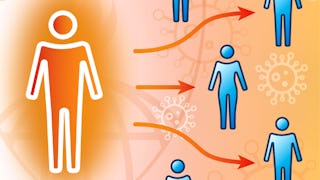This course covers approaches for modelling treatment of infectious disease, as well as for modelling vaccination. Building on the SIR model, you will learn how to incorporate additional compartments to represent the effects of interventions, such the effect of vaccination in reducing susceptibility. You will learn about ‘leaky’ vaccines and how to model them, as well as different types of vaccine and treatment effects. It is important to consider basic relationships between models and data, so, using the basic SIR model you have developed in course 1, you will calibrate this model to epidemic data. Performing such a calibration by hand will help you gain an understanding of how model parameters can be adjusted in order to capture real-world data. Lastly in this course, you will learn about two simple approaches to computer-based model calibration - the least-squares approach and the maximum-likelihood approach; you will perform model calibrations under each of these approaches in R.


Interventions and Calibration
This course is part of Infectious Disease Modelling Specialization

Instructor: Nimalan Arinaminpathy
3,363 already enrolled
Included with
(56 reviews)
What you'll learn
Identify the relationship between models and real-world epidemiological data
Incorporate treatment or vaccination into an SIR model, accounting for imperfect efficacy, and for different mechanisms of action
Perform simple calibrations of an SIR model against time-series data, selecting parameters to maximise the fit of the model to the data
Recognise two simple approaches to computer-based model calibration and perform model calibrations under each of these approaches in R.
Skills you'll gain
Details to know

Add to your LinkedIn profile
2 assignments
See how employees at top companies are mastering in-demand skills

Build your subject-matter expertise
- Learn new concepts from industry experts
- Gain a foundational understanding of a subject or tool
- Develop job-relevant skills with hands-on projects
- Earn a shareable career certificate

There are 4 modules in this course
Once you have captured the basic dynamics of transmission using simple mathematical models, it is possible to use these models to simulate the impact of different interventions. You will study approaches for modelling treatment of infectious disease, as well as for modelling vaccination. Building on the SIR model, you will learn how to incorporate additional compartments to represent the effects of interventions (for example, the effect of vaccination in reducing susceptibility). You will learn about ‘leaky’ vaccines and how to model them, as well as different types of vaccine and treatment effects.
What's included
5 videos5 readings2 discussion prompts11 ungraded labs
All models answering public health questions first need to be matched, or ‘calibrated’, against real-world data to ensure that model-simulated dynamics are consistent with what is observed. In this module, you will consider basic relationships between models and data. Using the basic SIR model that you've developed so far, you will calibrate this model to epidemic data. Through performing this calibration by hand, you'll gain an understanding of how model parameters can be adjusted so as to order to capture real-world data.
What's included
4 videos1 discussion prompt4 ungraded labs
In practice model calibration for compartmental models is rarely done by hand. Rather, we construct a function that summarises the goodness-of-fit between the model and the data and then use available computer algorithms to maximise this goodness-of-fit. In these next two modules, you will learn about two simple approaches to computer-based model calibration: the least-squares approach and the maximum-likelihood approach. You will perform model calibrations under each of these approaches in R.
What's included
3 videos6 ungraded labs
Please note - learning outcomes are the same across both this and the last module. In practice, model calibration for compartmental models is rarely done by hand. Rather, we construct a function that summarises the goodness-of-fit between the model and the data and then use available computer algorithms to maximise this goodness-of-fit. In these two modules, you'll learn about two simple approaches to computer-based model calibration: the least-squares approach, and the maximum-likelihood approach. You will perform model calibrations under each of these approaches in R.
What's included
4 videos1 reading2 assignments4 ungraded labs
Earn a career certificate
Add this credential to your LinkedIn profile, resume, or CV. Share it on social media and in your performance review.
Instructor

Offered by
Explore more from Public Health
 Status: Free Trial
Status: Free TrialJohns Hopkins University
 Status: Free Trial
Status: Free TrialImperial College London
 Status: Preview
Status: PreviewNew York University
 Status: Preview
Status: PreviewJohns Hopkins University
Why people choose Coursera for their career




Learner reviews
56 reviews
- 5 stars
78.57%
- 4 stars
16.07%
- 3 stars
1.78%
- 2 stars
3.57%
- 1 star
0%
Showing 3 of 56
Reviewed on Sep 20, 2020
Such a great learning experience. The course provided me with a comprehensive overview of the topics under concern. My gratitude to the instructors for creating such a valuable course.
Reviewed on Jun 28, 2020
A great learning experience, have to struggle a lot for the quiz, But in the end it helps to get better understanding of the concept and practice.
Reviewed on Jun 22, 2020
Excellent course videos, content, assignment quiz. Received very good support from instructor and other members/ learners on discussion forum.

Open new doors with Coursera Plus
Unlimited access to 10,000+ world-class courses, hands-on projects, and job-ready certificate programs - all included in your subscription
Advance your career with an online degree
Earn a degree from world-class universities - 100% online
Join over 3,400 global companies that choose Coursera for Business
Upskill your employees to excel in the digital economy
Frequently asked questions
To access the course materials, assignments and to earn a Certificate, you will need to purchase the Certificate experience when you enroll in a course. You can try a Free Trial instead, or apply for Financial Aid. The course may offer 'Full Course, No Certificate' instead. This option lets you see all course materials, submit required assessments, and get a final grade. This also means that you will not be able to purchase a Certificate experience.
When you enroll in the course, you get access to all of the courses in the Specialization, and you earn a certificate when you complete the work. Your electronic Certificate will be added to your Accomplishments page - from there, you can print your Certificate or add it to your LinkedIn profile.
Yes. In select learning programs, you can apply for financial aid or a scholarship if you can’t afford the enrollment fee. If fin aid or scholarship is available for your learning program selection, you’ll find a link to apply on the description page.
More questions
Financial aid available,

